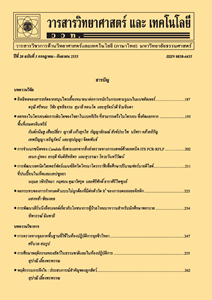ผลของปุ๋ยอินทรีย์คุณภาพสูงต่อการผลิตข้าวพันธุ์สุพรรณบุรี 1
Main Article Content
บทคัดย่อ
บทคัดย่อ
ปุ๋ยอินทรีย์คุณภาพสูงมีคุณสมบัติเด่น คือ มีธาตุอาหารสูงกว่าปุ๋ยอินทรีย์ทั่วไป จึงศึกษาผลของการใส่ปุ๋ยอินทรีย์คุณภาพสูงต่อการผลิตข้าวพันธุ์สุพรรณบุรี 1 โดยวางแผนการทดลองแบบสุ่มสมบูรณ์ จำนวน 10 ซ้ำ ประกอบด้วย ไม่ใส่ปุ๋ย และใส่ปุ๋ยอินทรีย์คุณภาพสูง อัตรา 12.5, 25 และ 50 กก.ไนโตรเจน/ไร่ ซึ่งอัตรา 12.5 กก.ไนโตรเจน/ไร่ เป็นปริมาณไนโตรเจนในรูปของปุ๋ยเคมีที่แนะนำตามค่าวิเคราะห์ดิน โดยให้การคาดคะเนปริมาณผลผลิตข้าวเปลือกไว้ คือ 816 กก./ไร่ การใส่ปุ๋ยแบ่งใส่ 2 ครั้ง เมื่อข้าวมีอายุ 10 วัน หลังย้ายปลูก และเมื่อข้าวเข้าสู่ระยะ IPP ผลการทดลองพบว่าการเจริญเติบโตและปริมาณผลผลิตข้าวเปลือกเพิ่มขึ้นตามอัตราปุ๋ยที่เพิ่มขึ้น โดยการใส่ปุ๋ยอัตรา 50 กก.ไนโตรเจน/ไร่ มีปริมาณผลผลิตข้าวเปลือกมากที่สุด โดยเฉลี่ย 892 กก./ไร่ ในขณะที่ การใส่ปุ๋ยอัตรา 25 และ 12.5 กก.ไนโตรเจน/ไร่ ได้ผลผลิตข้าวเปลือกโดยเฉลี่ย 624 และ 455 กก./ไร่ ตามลำดับ เช่นเดียวกับ ปริมาณโปรตีนในเมล็ดจะเพิ่มขึ้นเมื่ออัตราปุ๋ยเพิ่มขึ้น แต่ความหอมของข้าวจะลดลงเมื่ออัตราปุ๋ยเพิ่มขึ้น โดยข้าวที่ใส่ปุ๋ยอัตรา 50 กก.ไนโตรเจน/ไร่ มีปริมาณโปรตีนในเมล็ดมากที่สุด แต่มีปริมาณสารความหอม (2-AP) น้อยที่สุด ซึ่งส่งผลให้ความนุ่มเหนียวและความหอมของข้าวหุงสุกลดลง นอกจากนี้ ประสิทธิภาพการดูดไนโตรเจนจากปุ๋ยที่ใส่ ประสิทธิภาพการให้ผลผลิตจากปุ๋ยที่ใส่ และประสิทธิภาพการใช้ไนโตรเจนในการสร้างผลผลิตของการใส่ปุ๋ยอัตรา 50 และ 25 กก.ไนโตรเจน/ไร่ ไม่มีความแตกต่างกันทางสถิติ ดังนั้นผลการทดลองนี้จึงชี้ให้เห็นว่าการใส่ปุ๋ยอินทรีย์คุณภาพสูงอัตรา 50 กก.ไนโตรเจน/ไร่ ทำให้ข้าวพันธุ์สุพรรณบุรี 1 มีปริมาณผลผลิตข้าวเปลือกใกล้เคียงกับผลผลิตตามการคาดคะเนมากที่สุด แต่มีผลทำให้ความนุ่มเหนียวและความหอมลดลง และมีประสิทธิภาพการใส่ปุ๋ยต่อการผลิตข้าวเทียบเท่ากับการใส่ปุ๋ยอัตรา 25 กก.ไนโตรเจน/ไร่
คำสำคัญ : ข้าวสุพรรณบุรี 1; ปุ๋ยอินทรีย์; ผลผลิตข้าวเปลือก; ความนุ่มเหนียว; ความหอม
Abstract
Remarkable feature of high quality organic fertilizer is to provide more nutrient than others. Thus, the study on effect of high quality organic fertilizer on production of Suphan Buri 1 rice was undertaken in complete randomized design with 10 replications including 4 rates of high quality organic fertilizer application; no fertilizer, 12.5, 25 and 50 kg-nitrogen (N)/rai. The rate of 12.5 kg-N/rai was N recommended rate as chemical fertilizer according to soil analysis, giving predicted paddy yield by 816 kg/rai. The fertilizer was equally divided and applied at 10 days after transplanting and IPP stage. The results had shown that growth and paddy yield were increased by increasing fertilizer application rate. The rice applied by 50 kg-N/rai was highest in paddy yield, approximately 892 kg/rai. While, the average paddy yields of rice applied by 25 ad 12.5 kg-N/rai were 624 and 455 kg/rai. Similarly to protein content in grain which was increased by increasing the rate of fertilizer application. Contrast to aroma quality, the aroma compound (2-AP) was decreased by increasing the rate of fertilizer application. These leaded to less in tenderness and aroma of the rice applied by 50 kg-N/rai. Moreover, efficiency of N uptake, N use and N utilization were no significant difference between applying at 25 and 50 kg-N/rai. Therefore, the results had indicated that applying at the rate of 50 kg-N/rai can give the predicted paddy yield of Suphan Buri 1 rice but it affected on decreasing tenderness and aroma in grains and equivalent to efficiency of fertilizer application on rice production of applying at 25 kg-N/rai.
Keywords: aroma; organic fertilizer; paddy yield; Suphan Buri 1 rice; tenderness


